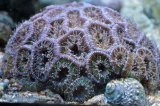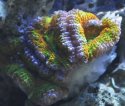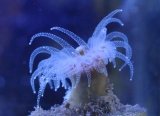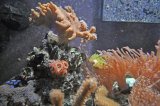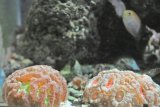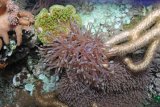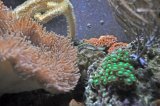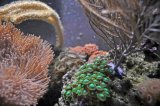Introduction |

|
First off, thanks to everyone at WAMAS, the TOTM committee, and the community in general. Having been involved in the marine hobby since '88 and living a transitory Navy life that has moved me to many places in the country and experience many clubs, I can say this is the best club I have ever run across and I am honored to share my modest system with y'all.
The saltwater bug started early for me; as my father was a saltwater hobbyist who started keeping marine tanks in the early 70s. He gave me a 10 gallon tank with some dolomite substrate and a piece of live rock; it really is amazing what will grow if you just let it… Although many years later, I learned all those colorful little anemones were majanos (at the time, there was a cost premium associated with “anemone rock!"). Several years after the 10 gallon, he turned over the regular maintenance of the family's 125 gallon reef. And, as they say, the rest is history.
|
Equipment
- Display: 58G Oceanic (36"x18"x20") drilled
- Sump: 75G Custom glass (36"x24"x21")
- Skimmer: Avast CS-1
- Lighting: Gutted Coralife Pro 250 MH fixture, Hamilton 250 MH fixture, and Coralife 150 MH pendant
- Controller: Apex w/ 2 EB8s
- Return Pump: Mag drive 9.5
- Circulation: 2x Tunze 6055 w/ nano wavebox, Frag 1x MP40, Refugium 2 x rio 2100
- ATO and AWC: SpectruPure LM3 w/ two WXMs
- Temp. Control: TECO TR-15 w/ integrated heater
|
Current Tank |
 |
I purchased my current 58 gallon display tank in ~2004 during a time when I was purchasing any tank that I could get my hands on inexpensively… This general mind-set pushed the total number of salt tanks upwards of 12 dedicated displays plus a bunch of other small culturing or project tanks. I gained a lot of experience quickly this way, but I also learned how busy this keeps you, how easy it is to lose track of maintenance schedules, and overall I started to burn out a bit on the hobby. Originally, I used the 58 as a grow-out tank for smaller FOWLR type fish such as a small harlequin tusk and Picasso trigger.
It went on that way for around four years, at which time I broke down all of my tanks, sold all of my livestock, and moved to DC for work. During my move to DC, I stopped and put all of my tanks in storage except for the 58; it was the only one that I chose to keep in my home. After a little pushing from my then-girlfriend (now wife), I decided to set the tank up as a seahorse tank. I previously had a dedicated seahorse system that was always one of my favorites, so it really didn't really take much pressure for me to indulge her.
After a few years with the seahorses, the itch to set up another tank and keep different things started to rise again. And after I thought about it for a very long time, I decided to move on to other things, which brings the tank to what it is now.
|
Aquarium Setup
|
|
My experience along the way has taught me a few things about set up marine reefs (often through the harsh experience of failing miserably).
- More water leads to slower changes in chemistry and water parameters and as long as you realize this can be a double-edged sword (since all changes - for better or worse - happen slowly), more is better. For my tank, although I have a 58 gallon display, I also have a 30 gallon frag tank and a 75 gallon sump tank (that includes a 50 gallon refugium).
- The tank should be set up such that it is easy to do the maintenance. If the maintenance is easy, then it is more likely to get done! With that in mind, I try to make everything that will need to be worked on very easily accessible. The 75 gallon sump is a 36 x 24 x 21 inch glass tank that is set sideways in my cabinet. This means that it sticks out the back by ~16" making the return area very accessible making any maintenance a breeze.
- Design your system to be resistant to any single failure. Let's face it, most of us have a significant amount of time, money, and emotional energy invested in our tanks. However, I'm also willing to bet that most of you hadn't put a ton of thought into a failure until after one occurred. What would happen in your system if the heater sticks on? If a snail finds its way into your overflow? If the power goes out? If your tank overflows? Etc.? In most aspects of my system I have incorporated at least a couple of features that minimize the chances of losing control of tank parameters if something fails. For example, I have normally dry drains for both the frag tank and the display such that if the drain gets clogged the water will overflow to the sump. I use a controller that shuts the heater and lights if the temperature rises above the expected value. I have a “wet" cabinet for the sump and equipment and a “dry" cabinet for all tank electronics to minimize the chances of humidity, moisture, or an overflow from causing damage.
|
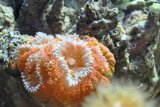
Water Parameters
- Salinity: 35ppt
- Temperature: 80-82 °F
- Alkalinity: 7-9 dkH
- Calcium: 425ppm
- Magnesium: 1350ppm
- Phosphate: 0ppm
- Nitrate: 0ppm
|
Water Movement
|
|
I am a big believer that high turnover ratios lead to a healthier tank. Note that I didn't say high flow as that's not necessarily the same thing. Lots of water moving slowly can be more beneficial that some water moving very quickly and flow should be tailored to the occupants. To this end, I do the flow in each of my tanks differently (the display, frag, and refugium). The 58 gallon display tank utilizes two Tunze 6055 power heads and a Tunze nano wave-box on a 7096 controller, the 30 gallon frag tank utilizes a single Vortech MP40, and the refugium has two rio 2100 pumps pointing in different directions that are alternated every three hours. I find this schedule in the refugium tends to keep detritus from settling within the ample supply of macro algae down there.
|
Lighting
|
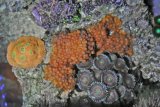 |
Although I have played some with LEDs, I still employ traditional metal halide lighting throughout the system. For me, LED technology is still developing too quickly. When the magnitude of change begins to slow a bit, I expect I'll convert over. But until then, the display uses a thoroughly gutted coralife fixture that has an electronic 250W ballast driving a 10k lamp and DIY LED actinic supplementation. The frag tank uses a 150W MH 6500k (for growth) pendant lamp and the refugium uses a 250W MH 6500k lamp.
|
Lighting Schedule
- 0000 - Refugium MH on
- 0800 - Refugium MH off
- 0800 - Frag MH on
- 1200 - DT actinic on
- 1400 - Frag MH off
- 1400 - DT MH on
- 2000 - DT MH off
- 2200 - DT actinic off
|
Filtration
|
|
I am a big proponent of biological filtration as the primary means. As such, the 50 gallons dedicated to my refugium are filled with a 6" deep sand bed and as much macro as space allows. Other than that, I occasionally add carbon in a bag to the return area and have an Avast CS1 protein skimmer.
|
Additives
|
|
There isn't anything that I specifically add to the tank other than freshly mixed, aged salt water and food. Although, I do very very frequent small water changes (150 times each day) with an automatic water changer, I consider this to be, hands down, the best money I have spent on my tank. I have found if I use a highly enriched salt mix (it has been Deltec H2Ocean salt for the past two years or so now) and do many small water changes, my ALK, calcium, and magnesium levels all stay where I want them. I change around 15 gallons, or 10%, of water per week.
|
Feeding
|
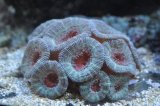 |
My tank is fed four times a day with varied pellet food via an automatic water changer and around once a day with one of the frozen preparations I have. Although I very much enjoy my tank, I don't enjoy being tethered to it. With the automatic water changer and the automatic water feeder, I can (and have on several occasions) go out of town for two weeks without worrying about it.
|
Livestock
|
|
The tank in its current form is what I affectionately call my “aimless" reef… I haven't fully transitioned from the mostly softy tank from when it housed the seahorses, yet I have added some new stuff. I think having themed or biotope-type tanks with a goal is a key aspect of some of the most beautiful tanks out there. Unfortunately, mine doesn't currently meet this, though it will!!
|
Fish
- Kole Tang
- Yellow Watchman Goby Pair
- Male Bartlett's Anthias
- Midas Blenny
|
Future Plans
|
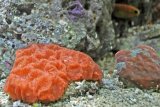 |
Just today as I write this, I received my official orders to be transferred to Norfolk, VA this December. This doesn't come as a surprise as I have been expecting and planning for this for quite some time now. Much of the system will remain unchanged with all of the equipment and livestock being moved with me. Although I will be taking the opportunity to make a new stand and set up an insulated and ventilated equipment cabinet in the garage. Also, I'll likely focus a bit more on the vision and direction for the tank.
Hopefully you all can learn from some of the things that I have done and incorporate some features into your own systems, just as I have done with other TOTMs so many times before!
|

